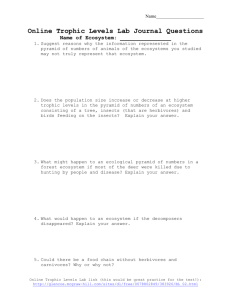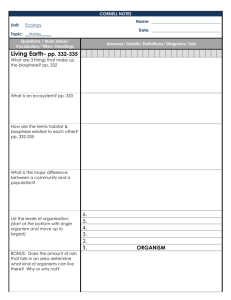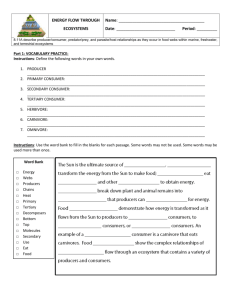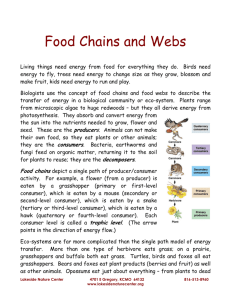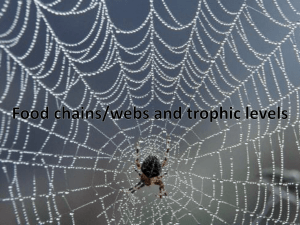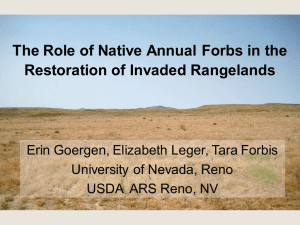The Natural Food Web. All Things Are Interconnected Most of us
advertisement
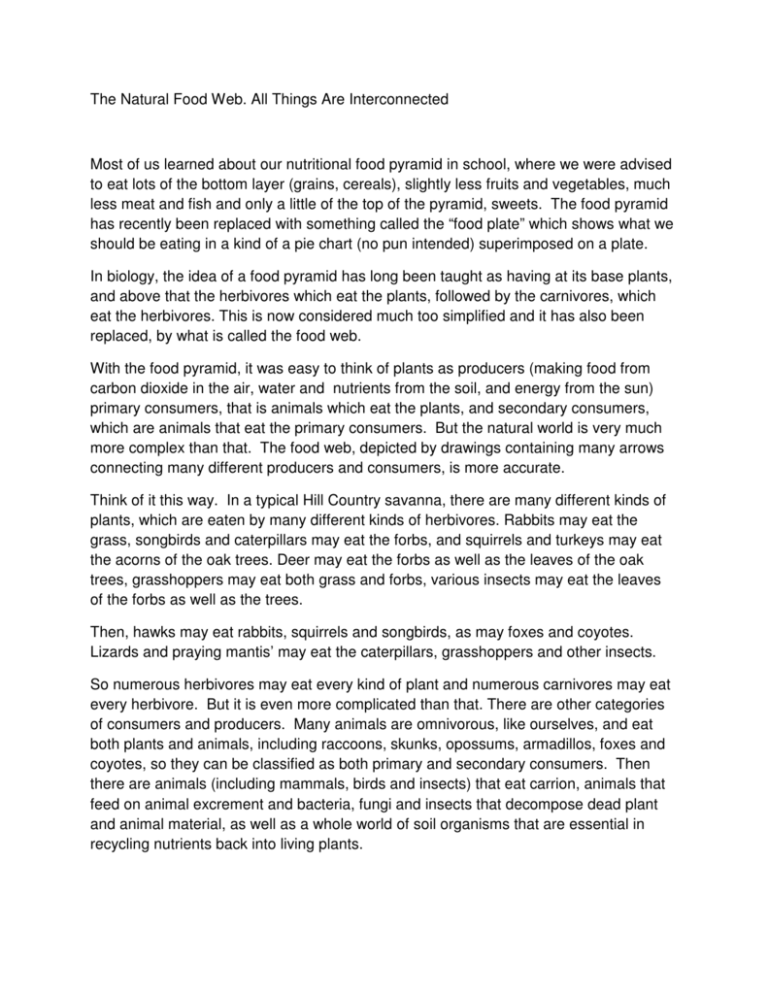
The Natural Food Web. All Things Are Interconnected Most of us learned about our nutritional food pyramid in school, where we were advised to eat lots of the bottom layer (grains, cereals), slightly less fruits and vegetables, much less meat and fish and only a little of the top of the pyramid, sweets. The food pyramid has recently been replaced with something called the “food plate” which shows what we should be eating in a kind of a pie chart (no pun intended) superimposed on a plate. In biology, the idea of a food pyramid has long been taught as having at its base plants, and above that the herbivores which eat the plants, followed by the carnivores, which eat the herbivores. This is now considered much too simplified and it has also been replaced, by what is called the food web. With the food pyramid, it was easy to think of plants as producers (making food from carbon dioxide in the air, water and nutrients from the soil, and energy from the sun) primary consumers, that is animals which eat the plants, and secondary consumers, which are animals that eat the primary consumers. But the natural world is very much more complex than that. The food web, depicted by drawings containing many arrows connecting many different producers and consumers, is more accurate. Think of it this way. In a typical Hill Country savanna, there are many different kinds of plants, which are eaten by many different kinds of herbivores. Rabbits may eat the grass, songbirds and caterpillars may eat the forbs, and squirrels and turkeys may eat the acorns of the oak trees. Deer may eat the forbs as well as the leaves of the oak trees, grasshoppers may eat both grass and forbs, various insects may eat the leaves of the forbs as well as the trees. Then, hawks may eat rabbits, squirrels and songbirds, as may foxes and coyotes. Lizards and praying mantis’ may eat the caterpillars, grasshoppers and other insects. So numerous herbivores may eat every kind of plant and numerous carnivores may eat every herbivore. But it is even more complicated than that. There are other categories of consumers and producers. Many animals are omnivorous, like ourselves, and eat both plants and animals, including raccoons, skunks, opossums, armadillos, foxes and coyotes, so they can be classified as both primary and secondary consumers. Then there are animals (including mammals, birds and insects) that eat carrion, animals that feed on animal excrement and bacteria, fungi and insects that decompose dead plant and animal material, as well as a whole world of soil organisms that are essential in recycling nutrients back into living plants. If one were to try to depict all of the interactions, or put another way, all of the paths of energy that flow through an ecosystem, it would be much too complex to represent on a single page diagram. And in fact there is more than one food web. There are also food webs based solely on all of the organisms in the soil, other food webs based on aquatic systems which include plants, fish, amphibians and insects, and various other special food webs. At each stage in a food web, when food and energy moves from one organism to another, energy is lost as heat. What this means is that it takes many times as much biomass of a primary producer (plants) to produce one pound of a primary consumer. And in turn, it takes many pounds of a primary consumer, eaten by a secondary consumer, to make a pound of secondary consumer. This loss of energy at each stage of the transfer is why we could feed an estimated ten times as many people if we all ate corn instead of feeding the corn to cows and then eating the cows. The complexity of this process is in many respects why a diverse ecosystem is fundamentally a healthy, stable system. The more different plants that grow, the more different species of consumers there are, the greater the resiliency of the system to withstand upsets, such as a disease which greatly reduces the population of some plant species, or a drought that affects different species differently, or the introduction of an exotic species which disrupts the natural food web. All of these kinds of upsets can best be tolerated by a healthy diverse ecosystem with all of its complex food web interactions. All things are interconnected. Until next time… Jim Stanley is a Texas Master Naturalist and the author of the book “Hill Country Landowner’s Guide”. He can be reached at jstmn@ktc.com. Previous columns can be seen at www.hillcountrynaturalist.org.

